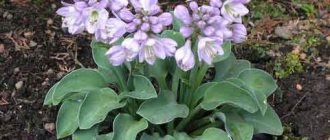Lilies of the valley: planting and care in the garden
Author: Natalya February 21, 2021 Category: Garden plants
Lily of the valley (lat. Convallaria) is a monotypic or oligotypic (including a small number of species) genus of the Asparagus family. Not so long ago, the lily of the valley flower was classified as a member of the Lily family or allocated to the Lily of the Valley family. The Latin name Lilium convallium, which was given to the plant by Carl Linnaeus, translates as “lily of the valleys.” The Russian name “lily of the valley” most likely came from the Polish language, and this plant is also called rejuvenator, rejuvenator, culprit and shirt. In the wild, lily of the valley is a forest flower; it grows in Europe, Asia and North America in deciduous, pine, mixed forests and floodplain oak forests.
Lily of the valley has been cultivated since the 16th century; in some towns in France, on the first Sunday in May, a lily of the valley festival is held. The healing properties of lily of the valley have been known since time immemorial and are still used in both traditional and folk medicine. Lily of the valley is also in demand in the perfume industry for creating fragrances.
CULTIVATION AND REPRODUCTION OF LILY OF THE LILY
May lily of the valley composition, properties, benefits and harms, use and contraindications
In the wild you can find various varieties and geographical races of lily of the valley, differing in height, leaf width, color and flower size. But these are all geographical races, because... The genus lily of the valley is represented by one polymorphic species - Convallaria majalis.
Lily of the valley can be found in forests, bushes or on mountain slopes. In the Alps, lily of the valley can be found at an altitude of 2300 m. In spring, lilies of the valley need moisture, but in summer they tolerate drought well. Lilies of the valley need slightly acidic (pH 5.0-6.6), not over-fertilized soil rich in humus. There is no need to remove fallen leaves from the area where lilies of the valley grow. In the fall, we recommend adding rotted manure or compost to them as mulch. Thanks to this, we will get abundant and high-quality flowering.
No forest garden is complete without lily of the valley. They easily get along with shade-tolerant plants, such as kupena, fern, tiara, hoofweed, ozhika, and others. Lily of the valley is a wonderful ground cover element in shrub borders. In mixed flower beds they can often be found in containers.
Reproduction of lilies of the valley is vegetative, and distant peduncles contribute to the rapid development of the flower.
Lily of the valley can be called one of the hardiest and most unpretentious crops. These flowers can survive even in urban conditions.
It is important for gardeners to know that lilies of the valley can be affected by lily of the valley nematodes - stem and stump nematodes. This disease affects the roots and rhizomes, so the diseased plant must be completely destroyed
You also need to keep an eye on pests. If you notice an orange-red bug with ten rows of dots on its back near the lilies of the valley, then you need to disinfect it. The onion cracker has its eye on your lily of the valley. In order for your flowers to please you and not cause inconvenience, you need to do simple prevention - weed control. Before planting lily of the valley, you must carefully inspect the planting material and wash the rhizome. Another important point is that you should not have an excessive excess of nitrogen, this can lead to the appearance of gray rot.
Remember, all parts of the plant are poisonous, although many animals happily eat them in pastures. The most poisonous are the rhizomes and fruits. Lily of the valley is very often used as a raw material in traditional medicine, but let us remind you, do not self-medicate, this is unacceptable. Lily of the valley is also one of the ingredients of paint; in the old days it was ground together with clay.
Planting and caring for lilies of the valley
- Planting: from September to early November.
- Flowering: April-May.
- Lighting: partial shade, shadow.
- Soil: moist, rich in organic matter, neutral or slightly acidic.
- Watering: only in abnormally hot times.
- Top dressing: humus or rotted manure, solutions of organic or mineral fertilizers.
- Reproduction: mainly by dividing rhizomes, less often by seeds.
- Pests: sawflies, nematodes, onion borers.
- Diseases: gray vegetable rot, gleosporiasis.
- Properties: lily of the valley is poisonous.
Lily of the valley flowers - description
The lily of the valley plant blooms in May-June for about two weeks. It reaches a height of 20-25 cm. The rhizome of lily of the valley is thin and creeping, numerous roots have a fibrous structure. The leaves of the lily of the valley, of which there are from one to three, are oval-oblong, broadly lanceolate, retain a lush green color until the end of July, then turn yellow and wither. The peduncle of the lily of the valley, which is formed from a flower bud, has a triangular cross-section in its upper part and is twisted in a spiral. Snow-white, fragrant, clustered flowers of 8-12 pieces are small bells 4 mm long and 5 mm wide with short stamens. By the end of flowering, the lily of the valley inflorescence darkens, the ovary appears - three-chambered lily of the valley berries, each of which contains 3-6 seeds. Lily of the valley seeds are poisonous, like the rest of the plant.
Interesting facts about lily of the valley
- A huge number of myths, fairy tales, and legends are known about the lily of the valley. One of them explains why green lily of the valley berries turn orange or red in late summer. The flower grieved very much, mourning the past spring. Small green “tears” were rolling down from his eyes. At the end of the summer, his “heart” could not stand it, and blood gushed out of it, coloring his “tears.”
- In one of the Brothers Grimm's fairy tales, Snow White's necklace fell apart when she was running away from her evil stepmother. The beads that fell on the grass turned into fragrant snow-white inflorescences of lily of the valley. The gnomes used these flowers as lanterns, and they served as shelter for cheerful sunbeams at night.
- The myths of Ancient Rome mention a story that once happened to the beautiful goddess Diana. Carried away by the pursuit of game, she found herself in an unfamiliar forest. The fauns living there tried to catch her. From the fast and long run, fragrant droplets of sweat appeared on the goddess’s body, which, touching the ground, immediately turned into fragrant flowers.
- The British have their own history of the appearance of this plant. These are drops of the blood of St. Leonard, the patron saint of forests, fields and meadows, who fought an evil dragon. Therefore, in England, lilies of the valley symbolize holiness and purity.
- Since the mid-16th century, every Sunday at the very beginning of spring, the French have celebrated “Lily of the Valley Day.” People give each other small real or embroidered bouquets, exchange souvenirs and postcards with images or symbols of these flowers.
- The Dutch believe that if lilies of the valley are planted in the newlyweds' garden or home, their love will not fade away, but will bloom again and again in the spring.
- Few people know that the famous astronomer and mathematician Nicolaus Copernicus was also an excellent doctor. Therefore, in many ancient portraits, artists depicted him holding a bouquet of snow-white lilies of the valley in his hands, which is a symbol of a skilled healer.
Growing lilies of the valley - features
Lilies of the valley are shade-tolerant. They are listed in the Red Book. Not only the fragrant flowers are beautiful, but also the wide dark green leaves of the lily of the valley. Lilies of the valley go well in the garden with ferns, lungwort, aquilegia, and anemones. Lilies of the valley grow incredibly quickly, and can crowd out any other flowers in a flowerbed. They behave the same way in prefabricated bouquets: other plants quickly fade in the vicinity of them. All parts of the plant are poisonous, so be careful when working with lilies of the valley.
Lily of the valley - May flower on the site
The slender and incredibly charming flowers of lily of the valley are known to everyone. In Latin, lily of the valley is called “convallaria maialis”, which translated into Russian means: “lily of the valleys, blooming in May.” On the slender arched arrow of the flower there are pearl buds and delicate white flowers.
After pollination by bees or bumblebees (although self-pollination is also possible), green and then bright red-orange berries appear.
All parts of the plant contain cardiac glycosides. Therefore, preparations from lily of the valley are used to treat diseases of the cardiovascular system, often in combination with preparations of valerian and hawthorn. And in the perfume industry, essences for perfumes are prepared from it.
Every year there is less and less lily of the valley left in our forests; everyone knows that this plant is listed in the Red Book. Let's learn how to grow it on the plot.
How to grow lilies of the valley
Lily of the valley is a shade-loving flower; choose a place for it in the garden under the trees. Soils are preferably moist, light, loose, fertile.
Reproduction is possible by segments of rhizomes (5-8 centimeters) with well-developed single apical buds. Peat humus compost is added before planting. Planted in spring or autumn. The rhizomes are planted to a depth of 3-4 centimeters, and 50-60 centimeters are left between the rows. In the first year after planting, lily of the valley almost does not bloom. But in the second spring he will decorate your garden with fragrant bells.
Lilies of the valley from seeds
You can grow this beautiful flower with seeds, and they bloom in the 3-4th year of life. Seeds need to be stratified two months before sowing. They are sown in rows and planted in holes to a depth of 2 centimeters. Sowing is carried out in such a way that the plant is no closer than 12-15 centimeters from the plant. If necessary, thinning is carried out in the rows.
Lilies of the valley can grow in a permanent place for many years.
Forcing lilies of the valley
After lilies of the valley grow in your garden, you can try to get the fragrant spring bells of this flower in the middle of winter. Try forcing lily of the valley. Forcing is not easy, requiring the creation of special conditions for plants, but the result will justify all the worries.
The beds with lilies of the valley are weeded, loosened, and well watered all summer - lilies of the valley love moisture.
After the first light frost, the plants are dug up. Thick, short, with blunt buds are transplanted into pots. The rest are planted again in the garden. Moreover, it is better to plant the more developed ones in a separate bed - by next autumn they will already be suitable for forcing. And leave the weaker ones where they grew.
Fill the pots with loose peaty leaf soil (or leaf humus) mixed with sand, but without manure. The substrate should not be too nutritious. Plant several roots in each pot. Plants can also be planted in shallow boxes or containers in rows at a distance of 3-4 centimeters. Before storing for the winter, water the soil in pots or boxes and cover with sand or moss with a layer of 10 centimeters. Place the boxes in a basement, cellar, barn or loggia, where the temperature in winter is +2 - +6 degrees. At low temperatures, plants retain the nutrients necessary for flowering and extend the dormant period.
Two weeks before forcing out lilies of the valley, bring pots or containers into the room. The main conditions for germination are warmth and humidity. Water the soil only with warm water and more often. It is very good to place the pots in containers filled with moss, cover them with moss too, transfer them to a radiator or stove and cover them with a plywood or cardboard box 10–12 cm high to maintain constant humidity.
After 17 - 20 days, the lilies of the valley will begin to grow, and the white bells will begin to bloom. Remove the layer of sand or moss and gradually accustom the plants to light. Place the pots on the windowsill. Shade plants and protect them from drafts.
To speed up forcing, boxes with plants can be placed in snow or covered with snow overnight before bringing them into the room. Frozen lilies of the valley bloom a week earlier.
Photo credits: m2633
Planting lilies of the valley and caring for the garden
When to plant lilies of the valley
If we are talking about when is the best time to plant lilies of the valley in open ground, then any gardener will answer you unequivocally: in the fall, from early September to early November. The most suitable place for them is under trees or bushes, which will create the shade they need for lilies of the valley, preventing the sun from quickly drying out the soil in the area. But remember that these plants still need light, otherwise the area will turn beautifully green, but you won’t see any flowers. And think about how to protect lilies of the valley from the wind.
Lilies of the valley in open ground
To grow convalia outdoors, you need to choose a suitable place. Garden lily of the valley prefers uniform humidity and shade. It is advisable to plant the plant in the shade of other shrubs or trees. The miniature plant will need protection from wind and drafts.
In neutral soil, lily of the valley can actively develop for more than 10 years. Lime must be added to slightly acidic soil. It is advisable to periodically fertilize the soil with manure and peat compost. You can buy superphosphate and potassium sulfate.
To grow convalia, it is necessary to prepare the planting site in advance.
For planting, it is necessary to prepare the site in advance. A year before planting, the soil should be dug up at a depth of 35 cm. The area should be covered with agrofibre and constantly cleared of weeds. You can also plant legumes.
Lilies of the valley should be planted in October or mid-April. For convalia it is necessary to make small holes. Silverberry sprouts with parts of the rhizome should be placed in the holes. The length of the rhizome should be about 7 cm. You should choose planting material that has two buds in the apical part. The rounded top of the sprout measuring more than half a centimeter guarantees flowering this year.
It is necessary to embed the soil to a depth of 3 cm. The interval between the grooves should be at least 20 cm. Densely planted sprouts are often affected by gray rot. Lily of the valley should be watered generously with warm, settled water.
After a month, when the lilies of the valley take root, you need to feed the plant with organic matter. During the dry period, the plant will not lose its decorative appearance. The formation of new inflorescences may completely stop. It is necessary to thin out the convalia once every 3 years.
You can find out all the features of the flower from the video:
Lilies of the valley after flowering
Lilies of the valley fade at the beginning of summer, but, having lost their fragrant inflorescences, they decorate the area with their wide dark green leaves for some time. To prevent lilies of the valley from taking over someone else's territory, fence the flowerbed with sheets of slate, digging them 40 cm into the ground.
When autumn comes, start replanting lilies of the valley, if the time has come, and if replanting is not planned this year, forget about lilies of the valley and move on to other flowers - lilies of the valley are frost-resistant, and nothing will happen to them in winter. When spring comes and the snow melts, use a rake to remove last year's dry leaves from the lily of the valley flower bed and wait for the first lilies of the valley to appear.
Choosing a place on a personal plot
Lily of the valley is a forest herb. In order for the lily of the valley to feel “at home” in your garden plot, you must follow the rules of cultivation and care, and also choose the most comfortable zone for the flowers.
Location and light
Lilies of the valley prefer a shaded location. However, the shading should not be dense, otherwise flowering will stop. In continuous shade, the plant devotes all its energy to growing leaves.
Plant flowers under trees or shrubs. Also avoid overly lit areas, which are characterized by active exposure to direct sunlight. Overheating of the soil in the root area negatively affects their growth.
It is also known that lilies of the valley do not like strong winds. A fence, house wall, and tall trees and shrubs will help protect the plants.
Soil for lilies of the valley
It is advisable to prepare the substrate for planting in advance, a year before planting or in the spring. The cultivated layer of soil should be quite deep (25-30 cm).
Read also: Spiraea Vangutta in landscape design - planting and care
Lilies of the valley prefer well-drained, light to medium loamy, cool, moist, slightly acidic soils (pH 5). But the plant also grows well on neutral soils. Strongly acidic soil is limed in advance.
In addition to lime, add peat compost, manure or humus, as well as a little simple superphosphate and potassium sulfate. In summer, keep the area fallow and do not let the land become overgrown with weeds. Before planting, do not forget to loosen the soil.
Types of lilies of the valley
Some botanists call the genus monotypic and distinguish only one species - May lily of the valley; all other species consider it to be varieties. This may be true, but since these varieties exist, we will present them to you. So, the types and varieties of lilies of the valley.
May lily of the valley (Convalaria majalis)
Grows in the temperate zone of the Northern Hemisphere. The inflorescence is a sparse raceme with 6-20 flowers on long stalks, very fragrant, white or pinkish, bell-shaped with bent teeth. Garden forms: Grandiflora with very large flowers, Proliferans - with double white flowers, Variegata - with yellow stripes on green leaves.
We sowed lilies of the valley, but there are no shoots, what should we do?
Every gardener dreams of growing lilies of the valley in their flowerbed to welcome spring with a stunning aroma and beautiful flowers. But what to do if the sown seeds do not sprout, how to grow lilies of the valley correctly?
May lily of the valley is an unpretentious plant that will suitably decorate any garden. It is distinguished by the presence of a developed root system, which branches intensively. The plant in its natural environment reproduces by bush division. Therefore, most often for growing in your garden, you use small pieces of rhizome (up to 7 cm), which have at least one developed apical bud.
Lilies of the valley in a summer cottage
The forest flower loves well-moistened, nutritious soils. It is better to choose a place in the shade of large trees or bushes. Since the plant has a creeping root system, it will grow throughout the garden without outside help. To limit growth, plastic borders from specialized stores are used.
The place for planting lily of the valley is prepared in advance. Fertilizers are applied:
- Deciduous humus or peat (10 kg per 1 sq. m).
- Mineral additives (superphosphate 100 g and potassium salt 40 g per 1 sq. m).
Planting grooves or holes are made, the depth of which depends on the size of the rhizomes. The sprouts are covered with a 1–2 cm layer of soil. About 10 cm is laid between the plants.
Planted in the fall, lilies of the valley will delight you with flowers in the first spring. Some people prefer to plant rhizomes “before winter.” Lilies of the valley tolerate the most severe frosts - down to -40°C and do not need shelter.
Read also: Korean fir: description, planting and care, varieties for growing
Lilies of the valley are very fond of organic fertilizers; they can be applied immediately after rooting. Plants will need minerals only after a year. In one place, May lilies of the valley can grow and bloom for more than 10 years.
At first, the planting will have to be weeded and loosened; an overgrown meadow of lilies of the valley does not need this.
Difficulties in propagation by seeds
It is very difficult to grow a full-flowering lily of the valley from seeds. Its seeds have very poor germination, and the sprouts develop very slowly to adulthood.
The low degree of germination is due to the fact that the seeds are not suitable for storage. To sow, you need to be patient and have a lot of material, since only a fifth will sprout.
It is better to sow seeds immediately in open, loose soil. Sowing depth is 2 cm. Even with ideal care, flowering will occur after 5-7 years.
How to grow lilies of the valley in your garden
The optimal place for this plant is the shade under garden trees and shrubs, where the soil retains moisture for a long time and does not overheat. The best soil is considered to be light loams containing a sufficient amount of humus at a pH level of 5.0. The plant responds well to nitrogen-containing fertilizers and rotted manure. From the second year you can add superphosphates and salts.
The best period for planting is autumn, but you can also do it in the spring, in mid-April. But it is better to prepare the site for spring planting in the fall, and only dig it up in April. Then the young shoots will take root more easily. At night, it is best to cover the seedlings with film or lutrasil to protect them from spring frosts.
The first shoots of lilies of the valley
In order to grow lilies of the valley yourself you need:
- Prepare the soil in advance, fence the bed with a metal strip so that the plant does not grow throughout the entire area.
- Dig the soil deeply (one and a half bayonets) along with humus.
- Prepare chopped rhizomes with leaf buds and buds.
- Form rows at a distance of 25-30 cm from each other, up to 5 cm deep.
- It is good to straighten the roots, avoiding bends and breaks, and place the seedlings 10 cm from one another.
- Sprinkle the sprouts with 2-3 cm of soil.
After rooting, you should periodically loosen the soil to a shallow depth (no more than a centimeter). Monitor soil moisture levels to prevent drying out by watering regularly.
Procurement of material and artificial forcing of lilies of the valley
The easiest way to get new plants is from rhizomes with flower buds. They can be easily distinguished from leaf ones by their rounded tops. In the fall (no later than October), the rhizomes are dug up, tied into bunches of several pieces and placed vertically in washed river sand.
Advice. Instead of sand, you can use wet sphagnum moss for storage.
The containers are left to overwinter in a cool place: a cellar, a compartment for vegetables in the refrigerator (no more than +2°C). Only with early forcing (December, early January) are lilies of the valley frozen three weeks before planting (-3...-5°C). Thawing is carried out gradually, thereby simulating a spring thaw. To do this, prepare a bath (+30°C), the water in which is changed several times.
Lily of the valley root
The best month for forcing lilies of the valley is the last calendar month of winter. By this time, the rhizomes have already woken up and are ready for planting in nutrient soil. The sprouts in containers are placed close to each other, watered abundantly and, covered with a transparent pact, placed in a warm, bright place. The greenhouses are shaded from direct sunlight. When the first green leaf appears, the shelter is removed and the temperature is lowered.
Attention! Watering is carried out only with water heated to +25°C.
Late forcing takes place in March. Typically, such plants do not produce abundant flowering. To prevent flower stalks from getting lost among the foliage, unexpanded leaves are removed with nail scissors.
Lilies of the valley in a pot need to be looked after: watered, sprayed, and mulched with peat on the top layer. Flowering occurs in less than a month. With the appearance of the first buds, lilies of the valley are provided with an air temperature of no more than +18°C. It is not advisable to propagate May lily of the valley by seeds.
How do lilies of the valley reproduce?
To make your garden plot look like an illustration from a gardening magazine, it is not at all necessary to spend your entire family budget on seedlings. For example, knowing how forest lilies of the valley reproduce, you can get their seeds at home and grow as many plants as you need to decorate your garden.
True, this method of growing a forest plant is quite troublesome, because small grains do not germinate well, but you can preserve your favorite variety for a long time.
Lily of the valley from seeds at home: surmountable difficulties of the process
The most common problem that all homegrown lily of the valley breeders have to deal with is the rapid aging of the seed. How does propagation by seeds occur in nature?
The berries that form in place of the flowers ripen, are separated from thin stems and fall into the ground, where young shoots emerge from the grains.
They are not stored for a long time - some varieties only have one season. Nature has no need and nowhere to store reserves of seeds for a long time, so she did not take care of extending their shelf life.
Another difficulty in obtaining lily of the valley seedlings from seeds is that it is not easy to guess the timing of their germination. Anyone who has at least once tried to germinate tree peony seeds knows how difficult it is to wait for the first shoots. Lily of the valley is also in no hurry to produce young shoots, and many gardeners simply do not wait for it - they plant something else on an “empty” plot, when suddenly, after a while, sharp arrows of lily of the valley leaves appear from under the ground.
Not all gardening enthusiasts are able to determine the ideal degree of moisture in the planting soil. In fact, this is not difficult - you just need to remember the conditions under which lilies of the valley grow in nature.
The ideal conditions for lilies of the valley are a hollow in the thicket of the forest, where the sun rarely hits, and the ground under the ripe fallen leaves always remains slightly damp.











